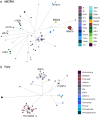Sex-biased patterns shaped the genetic history of Roma
- PMID: 32879340
- PMCID: PMC7468237
- DOI: 10.1038/s41598-020-71066-y
Sex-biased patterns shaped the genetic history of Roma
Erratum in
-
Author Correction: Sex-biased patterns shaped the genetic history of Roma.Sci Rep. 2020 Oct 20;10(1):18142. doi: 10.1038/s41598-020-75277-1. Sci Rep. 2020. PMID: 33077820 Free PMC article.
Abstract
The Roma population is a European ethnic minority characterized by recent and multiple dispersals and founder effects. After their origin in South Asia around 1,500 years ago, they migrated West. In Europe, they diverged into ethnolinguistically distinct migrant groups that spread across the continent. Previous genetic studies based on genome-wide data and uniparental markers detected Roma founder events and West-Eurasian gene flow. However, to the best of our knowledge, it has not been assessed whether these demographic processes have equally affected both sexes in the population. The present study uses the largest and most comprehensive dataset of complete mitochondrial and Y chromosome Roma sequences to unravel the sex-biased patterns that have shaped their genetic history. The results show that the Roma maternal genetic pool carries a higher lineage diversity from South Asia, as opposed to a single paternal South Asian lineage. Nonetheless, the European gene flow events mainly occurred through the maternal lineages; however, a signal of this gene flow is also traceable in the paternal lineages. We also detect a higher female migration rate among European Roma groups. Altogether, these results suggest that sociocultural factors influenced the emergence of sex-biased genetic patterns at global and local scales in the Roma population through time.
Conflict of interest statement
The authors declare no competing interests.
Figures




Similar articles
-
Founder lineages in the Iberian Roma mitogenomes recapitulate the Roma diaspora and show the effects of demographic bottlenecks.Sci Rep. 2022 Nov 4;12(1):18720. doi: 10.1038/s41598-022-23349-9. Sci Rep. 2022. PMID: 36333436 Free PMC article.
-
Population Genetics of the European Roma-A Review.Genes (Basel). 2022 Nov 8;13(11):2068. doi: 10.3390/genes13112068. Genes (Basel). 2022. PMID: 36360305 Free PMC article. Review.
-
European Roma groups show complex West Eurasian admixture footprints and a common South Asian genetic origin.PLoS Genet. 2019 Sep 23;15(9):e1008417. doi: 10.1371/journal.pgen.1008417. eCollection 2019 Sep. PLoS Genet. 2019. PMID: 31545809 Free PMC article.
-
Reconstructing Roma history from genome-wide data.PLoS One. 2013;8(3):e58633. doi: 10.1371/journal.pone.0058633. Epub 2013 Mar 13. PLoS One. 2013. PMID: 23516520 Free PMC article.
-
Origin of ethnic groups, linguistic families, and civilizations in China viewed from the Y chromosome.Mol Genet Genomics. 2021 Jul;296(4):783-797. doi: 10.1007/s00438-021-01794-x. Epub 2021 May 26. Mol Genet Genomics. 2021. PMID: 34037863 Review.
Cited by
-
The genetic footprint of the European Roma diaspora: evidence from the Balkans to the Iberian Peninsula.Hum Genet. 2025 Apr;144(4):463-479. doi: 10.1007/s00439-025-02735-z. Epub 2025 Mar 17. Hum Genet. 2025. PMID: 40095094 Free PMC article.
-
A Population Genetic Perspective on Subsistence Systems in the Sahel/Savannah Belt of Africa and the Historical Role of Pastoralism.Genes (Basel). 2023 Mar 20;14(3):758. doi: 10.3390/genes14030758. Genes (Basel). 2023. PMID: 36981029 Free PMC article. Review.
-
Population history modulates the fitness effects of Copy Number Variation in the Roma.Hum Genet. 2023 Sep;142(9):1327-1343. doi: 10.1007/s00439-023-02579-5. Epub 2023 Jun 14. Hum Genet. 2023. PMID: 37311904 Free PMC article.
-
Founder lineages in the Iberian Roma mitogenomes recapitulate the Roma diaspora and show the effects of demographic bottlenecks.Sci Rep. 2022 Nov 4;12(1):18720. doi: 10.1038/s41598-022-23349-9. Sci Rep. 2022. PMID: 36333436 Free PMC article.
-
Population Genetics of the European Roma-A Review.Genes (Basel). 2022 Nov 8;13(11):2068. doi: 10.3390/genes13112068. Genes (Basel). 2022. PMID: 36360305 Free PMC article. Review.
References
-
- Hancock I. We Are The Romani People. Hatfield: University of Hertfordshire Press; 2003.
-
- Fraser A. The Gypsies. New York: Wiley-Blackwell; 1995.
-
- Mendizabal I, et al. Reconstructing the population history of European Romani from genome-wide data. Curr. Biol. 2012;22:2342–2349. - PubMed
-
- Turner, RL. The Position of Romani in Indo-Aryan. (B. Quaritch, 1927).
Publication types
MeSH terms
Substances
LinkOut - more resources
Full Text Sources

